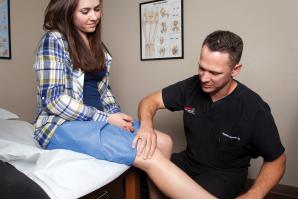When the pain began, Kevin assumed it was indigestion. He would occasionally experience bowel irregularity but would return to work anyway, fixing hot rods at a body shop in Carmichael. The 53-year-old didn’t grow alarmed until after about eight months, when he noticed a protrusion emitting from the side of his groin like a blister.
Kevin lacked adequate health insurance, and he had never met anyone with a hernia. His workplace, a small shop that he declines to name, is an environment of roaring engines, sleek paint and hot women — not the kind of place where men freely discuss genital discomfort … at least not in the clinical sense.
Kevin hit the Internet and diagnosed himself with an inguinal hernia. He purchased a hernia belt, which is like a jock strap that reduces pain and keeps your intestines from sticking out, and delayed what he knew would be an inevitable visit to the doctor. Meanwhile, under the surface of his skin, a tear had formed in Kevin’s abdominal wall and his intestines were pushing against the flesh.
“It progressively got worse,” he says. “The hernia got a lot bigger. It was excruciating. So I finally went to my general practitioner, and he suggested I go to a surgeon.”
After settling his insurance issues, Kevin underwent surgery in 2012, two years after his symptoms began. Complications arose. First, a water pocket developed in the hernia, preventing doctors from confirming the hernia with an ultrasound. Then came a CT scan. A surgery was performed to repair the hernia, and then another to drain the fluid. Kevin developed diverticulitis, inflamed or infected pouches in the wall of the colon. As a result, he now experiences recurrent pain in his stomach, fever, chills, bloating and gas, and diarrhea or constipation.
“It leaves the intestinal track very screwed up,” he says. “There’s nothing that a doctor can do about it. I just have to take steps to live with it.”
Those steps include an inability to eat processed foods, among other limitations. Kevin’s job as a mechanic involves some physical activity and has kept him in shape for the past few years. He has not yet returned full time.
“The lesson learned from my experience is don’t wait. As soon as you experience a hernia, see a surgeon,” he says.
Inguinal and femoral hernia repairs are among the most common surgeries in the nation, reports the U.S. Department of Health and Human Services. They have been studied for centuries and were first described as a “tear in the abdomen” by the Greek physician Hippocrates circa 400 B.C. But surgery wasn’t used to repair hernias until the 19th century. Results were poor until new surgical techniques emerged allowing for the reconstruction of the inguinal canal by suturing layers of muscles. Today, synthetic mesh devices are sometimes used instead of the sutures as a way to fortify the abdominal wall.
Health care giant Mayo Clinic describes symptoms of a hernia as a bulge near the pubic bone; a burning or aching at the bulge; and pain or discomfort, weakness or pressure in the groin. They also note that causes may include increased pressure in the abdomen or a pre-existing weak spot in the abdomen wall, straining, heavy lifting, excess weight, and chronic coughing or sneezing.
There are two surgical procedures used to repair an inguinal hernia — laparoscopic and open. Laparoscopic is less invasive, and patients who go this route typically experience less pain and can return to work and engage in activities quicker than an open surgery would allow.
Still, the results of the surgery can, in some cases, be just as uncomfortable as the hernia itself. Laparoscopic and open procedures both use a mesh product to reinforce torn muscle. During the placement process, nerves that route through the area of the surgery may have to be cut. This is to assure that the nerves do not entangle with the mesh, which can lead to severe pain.
“Immediate surgery is not necessary in all cases,” says surgeon Jack Friedlander with the Roseville Surgical Alliance. “Generally, once the hernia becomes systemic, it should be repaired. Some cases are observed depending on multiple factors including advanced age, sedentary or surgical risk. However, in general they are repaired.”
In an incarcerated inguinal hernia, the intestinal contents protrude outside the abdomen and cannot be pushed in or reduced during the surgeon’s examination. This is considered an emergency and calls for immediate surgery.
“The incarceration can swell and can cut off the blood supply. It’s called strangulation, and it is a life-threatening condition,” Friedlander says.
Pain occurs in most patients for various amounts of time, he adds. About 20 percent to 30 percent may suffer some degree of chronic pain. Long-term, severe pain can typically occur in up to 5 percent of patients.
Antibiotics are given to patients prior to surgery to combat infection. Nerve-block injections are used for pain. If pain persists, a patient may need to undergo another operation to sever nerves or to move or replace the mesh.
Friedlander recommends that patients do not lift heavy objects or get involved in strenuous activity for three weeks after surgery. After that, there are no restrictions and the patient is permitted to return to work.
Complications can be limited if a patient takes the time to find a competent surgeon, follow instructions and prepare for the surgery. The surgeon may ask overweight patients to lose weight before surgery to avoid strain on the abdomen. Patients who smoke may be asked to stop at least three weeks prior to the surgery to prevent weakness of the abdominal wall. Patients with diabetes should make certain to keep blood sugar under very tight control leading up to the surgery. If the patient has a history of heart or lung disease or other special problems, he should make sure that the specialist is in the loop so that problems are manageable.
“The first week is the roughest,” says Todd Heniford, a former president of the American Hernia Society. “After that, there should be gradual resolution of the pain followed by observation and management consisting of physical therapy, stretching, anti-inflammatories and time.”
Recommended For You

Hurts So Good
Yoga is good for you, but be careful boys
I’ve always snickered at yoga.It just seemed ridiculous. But men are flocking to yoga the way we once, in the ’80s, took to this thing called “jogging.” We’re learning that yoga bestows a slew of health benefits — physical, mental, even sexual. But new research also points to increased health risks for men, and this muddies the decision.

Avoiding the Pop
Why do so many women tear their ACL, and how can they prevent it?
In one of the crueler twists of sports, ACL tears often happen in freak accidents that you can’t really control. Seventy percent occur without contact. Even more cruelly, a woman is four times more likely than a man to tear the ligament — especially if she’s young and active.



